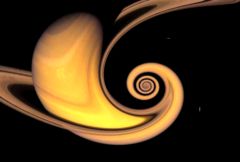S_WarpVortex
Twists the source clip into a vortex, about a given Center location. Use the Vortex Start parameter to adjust the amount of vortexing, and use Angle Offset to also apply a normal rotation. Vortex Speed can be used to automatically animate the amount of vortexing.In the Sapphire Distort effects submenu.
Inputs:
-
Source: The current layer. The input clip to be warped.
- Matte: Defaults to None. If provided, the amplitude of warping is scaled by the values of this input clip. Gray values internally scale the warping amplitude rather than simply cross-fading between the effect and the original source to allow more continuous results at the matte edges and more detailed control over the warping amounts. This input can be affected using the Blur Matte, Invert Matte, or Matte Use parameters.

|